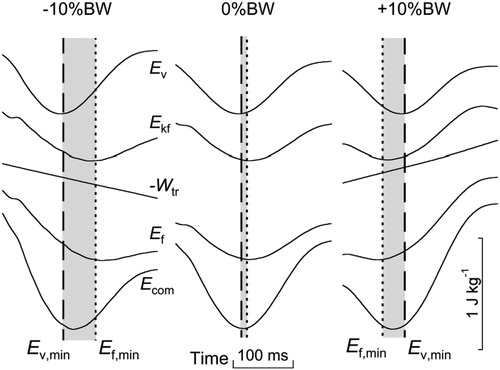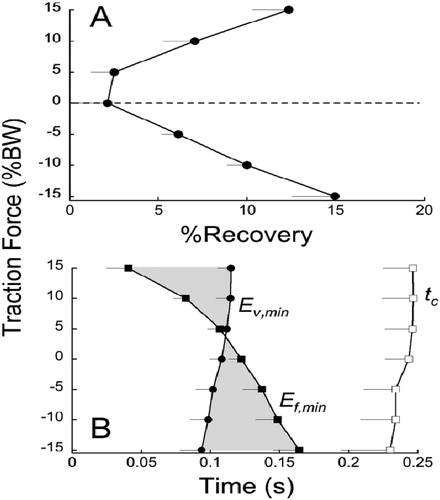 ?Mathematical formulae have been encoded as MathML and are displayed in this HTML version using MathJax in order to improve their display. Uncheck the box to turn MathJax off. This feature requires Javascript. Click on a formula to zoom.
?Mathematical formulae have been encoded as MathML and are displayed in this HTML version using MathJax in order to improve their display. Uncheck the box to turn MathJax off. This feature requires Javascript. Click on a formula to zoom.Keywords:
1. Introduction
When walking, the kinetic energy of the centre of mass of the body (CoM) due its forward movement (Ekf) and the mechanical energy due to its vertical movement (Ev) are out of phase, allowing energy exchange between the Ekf and Ev (Cavagna et al. Citation1976). On the contrary, in running, the time curves of Ekf and Ev are in phase. Consequently, the trajectory of the CoM reaches its lowest point close to the middle of the contact phase, when its forward velocity is minimal. In this case, the energy exchange between Ekf and Ev is almost nil.
It has recently been shown that during running on a slope, some energy (about 20% of the external work necessary to move the CoM relative to the environment, Wext) can be recovered through exchange between Ekf and Ev (Dewolf et al. Citation2016). This phenomenon occurs because on a slope, there is an imbalance between the positive and negative work performed. Consequently, in order to contain the increase in the positive (uphill) or negative (downhill) power necessary to change the height of the CoM, the time during which Ev increases/decreases is lengthened, whereas the time during which the CoM is accelerated/decelerated forwards does not change. Thus, when slope and speed increase the minimum of Ev takes place prior/after the minimum of Ekf, causing a period during which an energy exchange between Ekf and Ev occurs.
When moving with a hindering/aiding horizontal force, muscles need to produce work not only to maintain Ekf, but also to counteract this horizontal force (Wtr). In this way, the work done to sustain the movement of the CoM in the fore-aft direction (Ef) is equal to the sum of the Ekf- and Wtr-time curves. The present study is intended to investigate the shift between Ef and Ev, when moving against/with a traction force pulling the participant horizontally. We hypothesise that when running against/with a traction force, in order to reduce the power necessary for propulsion/braking, the duration of the positive/negative work phase needed to accelerate/decelerate the CoM will be lengthened, whereas the duration of the positive/negative work phase to increase the height of the CoM will be less affected by the traction. Because of this imbalance, the fluctuations between Ef and Ev will no longer be in phase and we expect that an energy exchange will occur between Ef and Ev (Cavagna et al. Citation2008). These modifications due to the hindering/aiding force will be compared to those observed when running uphill/downhill (Dewolf et al. Citation2016).
2. Methods
Eight male participants (age: 20.9 ± 1.6 years, mass: 72.8 ± 5.6 kg, height: 1.8 ± 0.1 m, mean ± sd) ran at 3.33 m s−1 on an instrumented treadmill (h/p/CosmosStellar, Germany) while being pulled forwards or backwards by a traction force representing 0%, ±5%, ±10% and ±15% of their body weight (BW). All participants gave informed consent.
An upper body harness was attached to a weight via an elastic rope and a pulley as in Asmussen and Bonde-Petersen (1974). Due to friction and inertia, the traction force varied within ±0.5% of BW during the step.
The three components of the ground reaction force (lateral Fx, vertical Fz and fore-aft Fy) and the traction force (Ftr) were measured every 1 ms by a 16 bits A/D convertor. The change in the traction force due to the vertical oscillation of the fixation point on the harness is in the order of 0.1% and was therefore neglected. From these data, the acceleration, velocity and displacement of the CoM were computed (Dewolf et al. Citation2016). Then, Ekf and Ev were calculated as:
(1)
(1)
(2)
(2)
where m is the body mass, Vv and Vf are the vertical and horizontal components of the velocity of the CoM and Sv is its vertical displacement. The work done against the traction (Wtr) and Ef were computed as
(3)
(3)
(4)
(4)
where Vb is the average velocity of the treadmill belt over the step analysed. The total energy of the CoM (Ecom) was computed as:
(5)
(5)
Energy exchange (%R) was quantified as (Cavagna et al. Citation2008):
(6)
(6)
where
are the positive and negative work done to sustain the movements of the CoM in the fore-aft (subscript f) and vertical (subscript v) directions and
are the positive and negative muscular work actually done to sustain the movement of the CoM relative to the environment.
3. Results and discussion
When a hindering/aiding force is applied to the body, the bouncing mechanism of running is modified (). When running without a traction force, the Ef and Ev curves are in phase. With a hindering horizontal force, Ef,min precedes Ev,min whereas with an aiding force Ef,min follows Ev,min. In the first case, the Evenergy lost during the grey zone of can be used to increase the kinetic energy of the CoM (Ekf) or to do work against the traction force (Wtr). In the second case, the Ef-energy lost during the grey zone can be used to increase the height of the CoM (Ev).
Figure 1. Typical mass specific energy-time curves of the COM during the contact phase of one participant running at 3.33 m s−1 without (0% BW) and with a traction force, hindering (+10% BW) or aiding (–10% BW) the runner. The dashed and dotted lines represent the minimum of the Ev-curve (Ev,min) and of the Efcurve (Ef,min), respectively. The grey zone corresponds to the period during which an energy exchange between Ev and Ef occurs. For other symbols, see text.

When the applied force becomes greater, the duration between the two minima is lengthened (). Consequently, the possibility of energy exchange between Ef and Ev (and vice versa) increases with the traction up to 10% with a hindering force and to 15% with an aiding force ().
Figure 2. Energy exchange (%R) (A) and duration of the contact phase (tc) as a function of the traction force when running at 3.33 ms−1. In panel B, the grey zone corresponds to the time shift between Ev,min and Ef,min where an energy transfer is possible. Symbols and bars represent the grand mean and standard deviations, respectively (when bars extend from the mean) of all participants (n = 8).

The changes in the bouncing mechanism observed when running with a hindering/aiding force (like the wind for example) are similar to the ones observed when running on slope. In both cases, the duration of positive/negative power production is lengthened to limit this increase in power. Furthermore, the additional work done is limited by transforming kinetic into potential energy and vice versa. This energy exchange allows to reduce the additional work by 1520%, depending on the magnitude of traction force or on the inclination of the terrain.
4. Conclusion and perspectives
When a horizontal traction force is applied to the body, the bouncing mechanism of running is modified. These primary results are obtained at an intermediate speed of 3.33 m s−1. In future experiments, the effect of speed on these modifications should also be analysed.
Acknowledgements
This study was funded by the Université Catholique de Louvain (Belgium).
References
- Asmussen E, Bonde-Petersen F. 1974. Apparent efficiency and storage of elastic energy in human muscles during exercise. Acta Physiol Scand. 92(4):537–545.
- Cavagna GA, Legramandi MA, Peyré-Tartaruga LA. 2008. Old men running: mechanical work and elastic bounce. Proc R Soc B. 275(1633):411–418.
- Cavagna GA, Thys H, Zamboni A. 1976. The sources of external work in level walking and running. J Physiol (London). 262(3):639–657.
- Dewolf AH, Peñailillo LE, Willems PA. 2016. The rebound of the body during uphill and downhill running at different speeds. J Exp Biol. 219(Pt 15):2276–2288.
